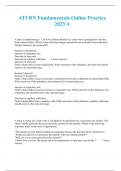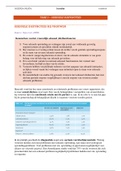-
1. Examen - Ati capstone fundamentals 2023
-
2. Examen - Ati capstone- fundamentals pre-assessment 2023
-
3. Examen - Rn vati fundamentals 2019 assessment (answered) retake 2022
-
4. Examen - Ati rn fundamentals online practice 2019 test b
-
5. Examen - Ati fundamentals proctored exam updated and graded a+
-
6. Examen - Ati rn fundamentals proctored focus 2023/2024
-
7. Examen - Ati rn fundamentals practice tests a & b 2023
-
8. Examen - Ati rn fundamentals exam 2016 form a and b proctored | 120+ questions and answers
-
9. Examen - Ati fundamentals exam
-
10. Examen - Ati fundamentals questions and answers with rationales
-
11. Examen - Ati fundamentals questions and answers with rationale
-
12. Examen - Ati fundamentals practice a 2023/2024
-
13. Examen - Ati fundamentals a, b and final ati fundamental review 2019
-
14. Examen - Ati fundamentals exams| questions and answers with rationale
-
15. Examen - Ati fundamentals answered a nurse is preparing to administer an injection of an opi...
-
16. Examen - Ati fundamentals 2019 proctored exam | fundamentals proctored exam
-
17. Examen - Ati fundamental proctored exam 2023/2024
-
18. Examen - Ati capstone fundamentals
-
19. Examen - Ati capstone fundamentals 2023 | questions and answers graded a+
-
20. Examen - Ati fundamentals 1 quiz
-
21. Examen - Ati fundamentals proctored exam updated and graded a+ | latest 2023/2024 177 question...
-
22. Examen - Ati fundamentals 2019 proctored review 166 questions with answers
-
23. Examen - Ati fundamentals proctor 2023
-
24. Examen - Ati fundamentals proctored exam study guide. ahip 2022/2023
-
25. Examen - Fundamentals exam #1 ati 100 questions with solutions
-
26. Examen - Ati fundamentals
-
27. Examen - Ati fundamentals practice test b
-
28. Examen - Ati fundamentals proctored exam
-
29. Examen - Rn vati fundamentals 2019 assessment
-
30. Examen - Rn vati fundamentals assessment
-
31. Examen - Ati rn fundamentals online practice 2019 a with ngn
-
32. Examen - Ati rn fundamentals online practice 2019 b with ngn
-
33. Examen - Rn fundamentals online practice 2019 a with ngn
-
34. Examen - Ati fundamentals practice test b
-
35. Examen - Ati rn fundamentals online practice 2019 a
-
36. Examen - Ati rn fundamentals proctored exam 2023/2024 100q/a
-
37. Examen - Ati 2019 fundamentals proctored exam final
-
38. Examen - Fundamentals proctored exam study guide 2023/2024
-
39. Examen - Rn fundamentals online practice 2019 b with ngn
-
40. Examen - Ati proctored fundamentals exam 2020
-
41. Examen - Ati rn fundamentals online practice assessment a 2023/2024
-
42. Examen - Ati fundamentals practice a 2019
-
43. Examen - Ati fundamentals practice a 2019
-
44. Examen - Nr 224 fundamentals final 2023/2024
-
45. Examen - Ati fundamentals retake proctored
-
46. Examen - Ati rn fundamentals online practice 2019 a with ngn
-
47. Examen - Ati fundamentals practice test b proctored 2023
-
48. Examen - Ati fundamentals exam 1 practice questions 2023/2024
-
49. Examen - Ati fundamentals exam 1 practice questions 2023/2024
-
50. Examen - Ati fundamentals proctored exam study guide
-
51. Examen - Fundamentals ati proctored exam study guide
-
52. Examen - Ati proctored fundamentals exam
-
53. Examen - Ati 2019 fundamentals proctored exam, ati fundamentals retake
-
54. Examen - Ati fundamentals (dynamic quizzes)
-
55. Examen - Ati fundamentals proctored exam
-
56. Examen - Ati fundamentals module 1 chapters 1-4, 16-17, 23-25
-
57. Examen - Ati fundamentals final exam (f1)
-
58. Examen - Ati rn fundamentals proctored tests a & b
-
59. Examen - Ati rn fundamentals practice b proctored
-
60. Examen - Ati rn fundamentals practice assessment
-
61. Examen - Ati rn fundamentals online practice assessment b 2019
-
62. Examen - Ati fundamentals practice test b
-
63. Examen - Ati fundamentals proctored exam study guide. 2022/2023
-
64. Examen - Ati fundamentals review module
-
65. Examen - Fundamentals ati practice b
-
66. Examen - Fundamentals ati questions - exam 1
-
67. Examen - Ati fundamentals practice test a with ngn
-
68. Examen - Fundamentals cms midterm 2023/2024
-
69. Examen - Ati proctored fundamentals review questions 2023/2024
-
70. Examen - Ati fundamentals cms proctored exam 2023/ 2024 latest!!! 210 questions and verified a...
-
71. Examen - Ati fundamental cms 2023/2024
-
72. Examen - Ati pn fundamentals b
-
73. Examen - Ati fundamentals practice a, b, & final, ati fundamentals review 2019
-
74. Examen - Nclex pn fundamentals
-
75. Examen - Pn fundamentals 2017
-
76. Examen - Ati fundamentals retake
-
77. Examen - Ati fundamentals remediation 2023/2024
-
78. Examen - Ati fundamentals 2
-
79. Examen - Ati fundamentals 2 quiz 2023
-
80. Examen - Ati fundamentals b 25 questions only with answers 2023/2024
-
81. Examen - Ati fundamentals proctored 2023/2024
-
82. Examen - Ati fundamentals proctor 2023
-
83. Examen - Fundamentals ati practice b 2023/2024
-
84. Examen - Ati fundamentals
-
85. Examen - Ati rn fundamentals online practice 2023 a
-
86. Examen - Ati fundamentals proctor 2019
-
87. Examen - Ati fundamentals proctored exam study guide 2024
-
88. Examen - Ati fundamentals proctored exam a&b
-
89. Examen - Ati 2023 fundamentals proctored exam, ati fundamentals retake
-
90. Examen - Ati rn fundamentals proctored exam
-
91. Examen - Ati proctored fundamentals exam
-
92. Examen - Ati pn fundamentals online practice 2020 b with ngn
-
93. Examen - Ati fundamentals proctored exam study guide
-
94. Examen - Ati fundamental proctored exam| fundamentals proctored exam| graded a+| latest 2023/2...
-
95. Examen - Ati fundamentals proctor 2023
-
96. Examen - Ati rn fundamentals proctored exam
-
97. Examen - Fundamentals online practice 2019 a with ngn
-
98. Examen - Ati rn fundamentals proctored exam 2023
-
99. Examen - Ati rn fundamentals online practice 2023 b
-
100. Examen - Ati fundamentals proctor 2023
-
101. Examen - Ati fundamentals proctor 2023
-
102. Examen - Ati fundamentals proctor 2023
-
103. Examen - Ati fundamentals proctored exam
-
104. Examen - Ati rn fundamentals proctored exam
-
105. Examen - Ati fundamentals practice exam a
-
106. Examen - Rn fundamentals online practice 2019 b with ngn
-
107. Examen - Ati pn fundamentals 2020 with ngn practice
-
108. Examen - Ati rn fundamentals online practice 2019 b with ngn
-
109. Examen - Pn fundamentals online practice 2020 b with ngn
-
110. Examen - Ati fundamentals online practice 2020 b
-
111. Examen - Ati fundamentals online practice 2019 b
-
112. Examen - Ati rn fundamentals online practice 2019 a
-
113. Examen - Ati rn fundamentals online practice 2019 b w. ngn
-
114. Examen - Ati fundamentals 1 quiz 2024
-
115. Examen - Exam (elaborations) ati rn fundamentals online practice 2023 a ati rn
-
116. Examen - Ati rn fundamentals proctored exam 2024
-
Montrer plus





